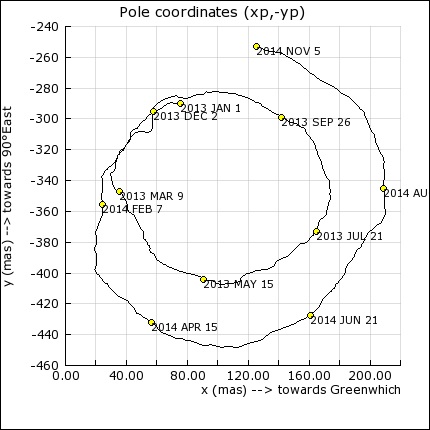International Earth Rotation and Reference Systems Service
International Service for Earth Rotation and Reference Systems ( abbreviation IERS, English International Earth Rotation and Reference Systems Service, . Formerly only International Earth Rotation, English International Earth Rotation Service ) is an international organization for the measurement and calculation of the Earth rotation parameters and a reference system for astronomical and geographic position data.
The Earth Rotation is operated by international organizations of geodesy and astronomy and processes all geodetic measurements to artificial satellites and quasars to derive continuously calculate the position of the Earth in astronomical fundamental system.
From the International Latitude Service to IERS
It was founded in 1899 - a few years after the discovery of the terrestrial polar motion - Theodor Albrecht, Wilhelm Foerster and Friedrich R. Helmert in Berlin as International Latitude Service. Observation Technically, it included then 5 globally distributed fundamental stations, all of which ' were on the same latitude of 39 ° 08 in order to detect the slightest changes in the latitude by observation of star passages after Horrebow - Talcott method can.
Since the 1970s, these visually - astrometric measurement method was complemented by the automatic method of satellite geodesy and replaced later. This increased the accuracy tenfold. The data are combined in the space of a few years now centimeter- earth models, see IERS Terrestrial Reference System ( ITRS ) and ITRF2000. Upon introduction of the automatic measurement, the Central Bureau of the IERS was in Washington (USA ) or Ōshū (Japan). Today it has its headquarters back in Germany (Frankfurt am Main).
The measurements of the IERS also contribute to the calculation of Coordinated Universal Time ( UTC), which the International Bureau of Weights and Measures ( BIPM) is coordinated in Paris. The BIPM is for instance the basis of recommendations of the IERS leap second in Coordinated Universal time, so as to maintain an exact match as possible with the solar time.
Combination of several techniques
For IERS service account in particular the following measurements:
- VLB interferometry with large radio telescopes for extragalactic radio sources ( several hundred almost point-like quasars )
- GPS position fixes from hundreds of satellite stations and the related system GLONASS (in future also the European Galileo )
- Satellite Laser Ranging by special laser satellite
- Measurements of the 50 Doppler stations of the type DORIS
- Radar distance measurements of the system PRARE that is small enough, despite its accuracy in the centimeter range, in order to equip non- geodetic satellites.









